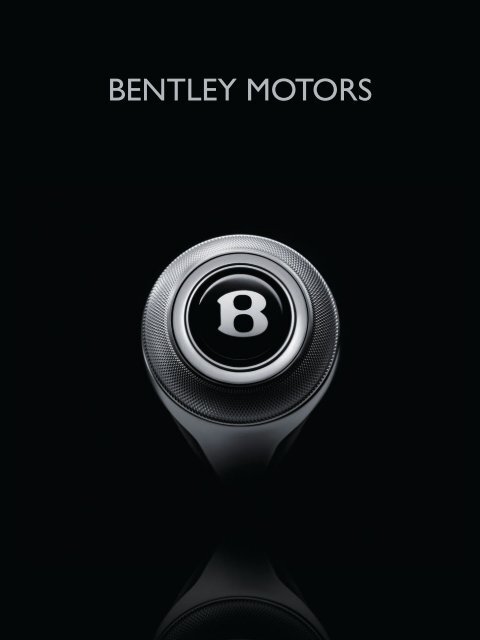Bentley pages
You also want an ePaper? Increase the reach of your titles
YUMPU automatically turns print PDFs into web optimized ePapers that Google loves.
BENTLEY MOTORS
<strong>Bentley</strong> Motors is the world-famous maker of luxury, hand-crafted high<br />
performance cars.<br />
Our founder, W.O <strong>Bentley</strong>, set out his ambition 90 years ago: ‘To build a<br />
good car, a fast car, the best in its class’. It is a philosophy the Company<br />
has followed passionately ever since.<br />
30 20<br />
It was in the 1920s that the marque was defined: countless victories at<br />
Le Mans and Brooklands, the <strong>Bentley</strong> Boys and their glamorous soirees<br />
on the French Riviera. The likes of Woolf Barnato, John Duff and Tim<br />
Birkin created the <strong>Bentley</strong> legend and it is this colourful heritage and<br />
spirit of excitement that still infuses the brand today.<br />
The story of the <strong>Bentley</strong> Boys is a fascinating one and is often<br />
chronicled. What is less well known is the Company today. How many<br />
know that <strong>Bentley</strong> is the world’s biggest luxury car company? That it is<br />
a full automotive producer – designing, developing and manufacturing<br />
all its cars in Britain? That it has over 140 dealerships in 60 countries<br />
world-wide? Or that it is one of the most successful luxury goods<br />
brands, with sales that increased 10-fold over just 10 years?<br />
The renaissance of <strong>Bentley</strong> began in 1998, when it became part<br />
of Volkswagen Group. This provided access to financial and technical<br />
resources that were not previously available. As a result, more than<br />
£1 billion was invested in <strong>Bentley</strong> and its Crewe headquarters making<br />
the facility fit for the 21st century.<br />
That investment transformed the fortunes of the Company.<br />
The combination of performance, luxury and craftsmanship were<br />
matched to modern technology and engineering excellence,<br />
strengthening the reputation of the cars and the Company as a whole.<br />
A string of new products were introduced starting first with the<br />
now-iconic Continental GT, broadening the marque’s appeal to new<br />
customers all over the world. More recently it resulted in the new<br />
Mulsanne – the flagship that encompasses everything for which <strong>Bentley</strong><br />
stands; a car we believe to be the very pinnacle of British motoring.<br />
Yet while the Pyms Lane factory in Crewe has changed physically,<br />
it remains dependent on the skills and craftsmanship of the people<br />
who work there, some for generations. Today <strong>Bentley</strong> Motors draws<br />
customers, enthusiasts and many other visitors from around the world.<br />
This publication is designed to give an insight into that experience,<br />
to tell the story of <strong>Bentley</strong> the Company – the plant, the products, the<br />
people. We remain very proud of our history and heritage as well as<br />
being confident about our future as a global automotive manufacturer.<br />
We hope that the following <strong>pages</strong> will explain why.<br />
Photography: Nick Dimbleby, Dominic Fraser,<br />
Charlie Magee & David Shepherd<br />
Thank you for your interest.<br />
<strong>Bentley</strong> Motors<br />
5
BENTLEY<br />
History of <strong>Bentley</strong><br />
6
BENTLEY<br />
THE ORIGINS<br />
W.O described his designs as ‘fast, sporting cars that are also comfortable and civilised’.<br />
The ‘<strong>Bentley</strong> Boys’ helped<br />
drive the company to<br />
success in the 1920s<br />
W.O <strong>Bentley</strong><br />
8<br />
Although <strong>Bentley</strong> famously won the gruelling<br />
Le Mans 24 Hour race five times between<br />
1924 and 1930, in the early days the company<br />
was not in a strong financial position. It was<br />
supported from 1926 to 1931 by the chairman<br />
Woolf Barnato, one of the wealthy ‘<strong>Bentley</strong><br />
Boys’ – a group of social celebrities and amateur<br />
racing drivers who drove <strong>Bentley</strong> to success<br />
in the 1920s. Their new interpretation of the<br />
historic ‘Grand Tour’ developed <strong>Bentley</strong>’s<br />
reputation for ‘grand touring’, as they travelled<br />
across Europe, relishing the thrill of motoring.<br />
Their endeavours ranged from the Le Mans<br />
24 Hour Race to racing one of the fastest trains<br />
of the day – the Blue Train from the French<br />
Riviera to Calais.<br />
After the heady days of the 1920s, <strong>Bentley</strong><br />
went into administration in 1931. The company<br />
was acquired by Rolls-Royce and for the next<br />
70 years Britain’s two most prestigious car<br />
marques were run in parallel.<br />
Kidston and Barnato at Le Mans, 1930
BENTLEY HISTORY<br />
<strong>Bentley</strong> R-Type Continental<br />
Rolls-Royce and <strong>Bentley</strong> car production<br />
moved to Crewe in 1946. The site in Pyms<br />
Lane was built in 1938 to produce Rolls-<br />
Royce Merlin engines for military aircraft<br />
and played an important part in equipping<br />
Allied forces in World War II. The first postwar<br />
<strong>Bentley</strong>, the MkVI, was the first to offer<br />
a standard steel body supplied complete<br />
from the factory; all pre-war <strong>Bentley</strong>s had<br />
been sold in rolling chassis form and bodied<br />
by independent coachbuilders. The most<br />
significant of the early <strong>Bentley</strong>s to be built at<br />
Crewe was the R-Type Continental in 1952.<br />
At the time, its top speed of 120mph made<br />
it the world’s fastest four-seat production car.<br />
Its elegant, flowing, two-door body was the<br />
inspiration for the first new model produced<br />
under Volkswagen’s ownership.<br />
The first <strong>Bentley</strong> with unitary construction<br />
(body and chassis as one piece) was the<br />
T-series of 1965, sister model of the<br />
Rolls-Royce Silver Shadow. At the time,<br />
<strong>Bentley</strong> lived in the shadow of Rolls-Royce;<br />
T-series sales amounted to less than 10 per<br />
cent of the Shadow’s.<br />
<strong>Bentley</strong> flowered once again as a sporting<br />
marque with the introduction of the 140mph<br />
Mulsanne Turbo in 1982. The stalwart<br />
6.75 litre V8 engine, which had been introduced<br />
in 1959, was boosted to 300 horsepower by<br />
fitting a turbocharger. The name referred<br />
to <strong>Bentley</strong>’s former glories; Mulsanne is the<br />
village near Le Mans at the end of the circuit’s<br />
5.5km Hunaudières straight.<br />
<strong>Bentley</strong> Mark VI<br />
9
BENTLEY<br />
JEWEL IN THE CROWN<br />
A new partnership with Volkswagen<br />
10<br />
Rolls-Royce and <strong>Bentley</strong> Motor Cars was<br />
merged with the Vickers engineering group in<br />
1980. The Crewe factory assembled the cars,<br />
trimmed and finished them with the finest<br />
leather and wood veneer, and built the V8<br />
engine – which, in a very different form, still<br />
powers the latest Mulsanne.<br />
With the introduction of the <strong>Bentley</strong> Arnage<br />
in 1998, the tables were turned. Bodyshell<br />
production was brought in-house and, for<br />
a period, engines out-sourced, requiring<br />
significant changes to the Crewe facilities and<br />
re-training of many of its technicians.<br />
In 1998 Vickers sold Rolls-Royce and <strong>Bentley</strong><br />
Motors. BMW bought Rolls-Royce, while the<br />
Volkswagen Group bought <strong>Bentley</strong> Motors,<br />
including its historic Crewe factory and the<br />
unique skills of its craftsmen.<br />
Ferdinand Piëch, the chairman of Volkswagen<br />
at the time, described <strong>Bentley</strong> as the ‘jewel<br />
in the crown’ of the automotive group.<br />
He promised a major expansion, with a range<br />
of cars of a new type and at a price point<br />
below the traditional <strong>Bentley</strong>s, designed<br />
to appeal to a new generation of customers.<br />
The result was the Continental GT coupé,<br />
introduced in 2003, and the remodelling of the<br />
Crewe works.<br />
The company became <strong>Bentley</strong> Motors<br />
Limited officially on 16 September 2002, to<br />
coincide with W.O <strong>Bentley</strong>’s birthday.<br />
The company’s new owners had a vision for<br />
a ‘mid-sized’ <strong>Bentley</strong> which could increase<br />
production to 9,000 cars a year. The design of<br />
MSB, as it came to be called, was to take place<br />
at Crewe.<br />
The Continental GT was designed to appeal to a<br />
new generation<br />
To accommodate the design process, the<br />
engineering team at Crewe was increased<br />
from 200 to 550, and the design studio was<br />
extensively enhanced. The physical changes<br />
at Crewe were also extensive; 400 contractors<br />
worked over 18 months to modernise and<br />
re-equip the buildings, some of which had<br />
hardly changed since 1938. Most car factories<br />
are what the motor industry calls ‘screwdriver<br />
plants’, assembling cars from parts developed<br />
and produced elsewhere. The plan was to make<br />
the Crewe plant highly integrated, capable of<br />
designing, developing and manufacturing all<br />
parts of <strong>Bentley</strong> cars, including the engines.<br />
Over £500 million was invested in the<br />
re-design of the facilities at Crewe. The<br />
30,000m 3 main assembly hall was adapted<br />
into a new production line for the Continental<br />
series and kitted out with the latest tools,<br />
conveyor and materials handling systems.<br />
A smaller, more labour-intensive line to one<br />
side of the Continental line builds the larger<br />
cars at a slower pace.<br />
By the time production of the Continental GT<br />
started, the Crewe workforce had increased<br />
to over 3,000. Many existing staff had to be<br />
re-trained for new skills and tasks.<br />
For the introduction of the new Mulsanne in<br />
2010, <strong>Bentley</strong> has constructed a new bodyshop.<br />
Making high-precision bodies in low volume<br />
requires special skills and the new bodyshop<br />
has a suite of machinery that combines<br />
automation with individual craftsmanship.
BENTLEY HISTORY<br />
<strong>Bentley</strong> workers fitting the undertray onto a Continental GT Diamond series – one of a limited edition of cars to celebrate 60 years of building <strong>Bentley</strong>s at Crewe<br />
11
BENTLEY<br />
RESEARCH & DEVELOPMENT<br />
<strong>Bentley</strong> has always stood for first-class engineering, as the fine cars of its past testify.<br />
A large percentage of all the <strong>Bentley</strong>s ever made still exist; a tribute to W.O and his successors.<br />
Today, <strong>Bentley</strong> is the third largest Research and<br />
Development (R&D) investor in the UK’s automotive<br />
sector 1 and the 18th largest nationally. Even though it<br />
manufactures far fewer vehicles than many of the volume<br />
car producers, everything from engineering and research to<br />
styling and design, takes place in Crewe.<br />
R&D activities range from engine improvement to<br />
reducing carbon emissions and other pollutants to research<br />
into new materials such as composites which are helping to<br />
reduce weight and improve safety and durability.<br />
There is no better way to illustrate the R&D journey<br />
at <strong>Bentley</strong> than to follow the development of the new<br />
Continental GT which began in 2002.<br />
The Continental GT brought a step change for design and<br />
development at Crewe.<br />
As well as increasing manpower and improving facilities,<br />
there was a complete overhaul of the development<br />
process. For the first time, <strong>Bentley</strong> adopted simultaneous<br />
engineering, where all the key aspects of the design are<br />
agreed at the outset and progress in parallel.<br />
Simultaneous engineering is altogether more efficient than<br />
the traditional step-by-step progression used previously,<br />
saving both time and money. It is directed by a project<br />
team which puts specialists for exterior and interior<br />
design, chassis, powertrain, electrical and whole vehicle<br />
engineering alongside purchasing, finance, manufacturing,<br />
marketing, quality and logistics.<br />
Once it was agreed that the first of this new series of<br />
<strong>Bentley</strong>s would be two-door, four-seat coupé, the styling<br />
of what became the Continental GT was done entirely at<br />
Crewe. Though a completely different concept from any<br />
other car in the <strong>Bentley</strong> family, the design inspiration came<br />
from the R-Type Continental from the 1950s.<br />
The new Continental series would be the fastest road<br />
going <strong>Bentley</strong> ever made, with a potential maximum<br />
speed of 200mph. This was an immense task requiring the<br />
adoption of all the latest safety and security systems, from<br />
air bags to electronic stability control. In addition, the cars<br />
were equipped with four-wheel drive, the largest and most<br />
powerful brakes, and a very sophisticated air suspension<br />
system. Close attention was paid to aerodynamics to ensure<br />
stability at high speed; to reduce rear end lift and achieve<br />
1. Department for Business, Innovation & Skills, 2010 R&D Scoreboard<br />
aerodynamic balance, <strong>Bentley</strong> engineers developed an<br />
underbody diffuser and a rear spoiler that automatically<br />
deploys at motorway speeds.<br />
As well as meeting <strong>Bentley</strong>’s (and Volkswagen’s) demanding<br />
safety and quality standards, its new models would have<br />
to comply with a raft of rules and regulations which differ<br />
from country to country. It was an important principle that<br />
any new <strong>Bentley</strong> be suitable, without modification, for all<br />
world markets.<br />
For the Continental range – where the Flying Spur saloon<br />
and GTC convertible followed the GT coupé – 71 test<br />
vehicles and 150 crash tests were required.<br />
It is in these areas – testing, certification and aerodynamic<br />
optimisation – where <strong>Bentley</strong>’s connection to the huge<br />
resources of the Volkswagen Group pays off. The synergy<br />
works both ways. While <strong>Bentley</strong> is able to benefit from<br />
the Group’s experience – and its buying power for supplied<br />
components and systems – engineers and production<br />
specialists from associate companies want to visit Crewe<br />
to learn the skills needed to create the world’s finest<br />
car interiors.<br />
Car engines have to meet regulations covering – among<br />
other things – fuel consumption, exhaust emissions, noise<br />
and durability.<br />
For <strong>Bentley</strong>, the W12 – the ‘W’ describes what is, in effect,<br />
two narrow-angle V6 engines on a common crankshaft<br />
– was to be fitted with two turbochargers, new inlet and<br />
exhaust systems, and many unique internal components as<br />
well as the latest electronic management system.<br />
Testing, certification<br />
and aerodynamic<br />
optimisation is where<br />
<strong>Bentley</strong>’s connection to<br />
the huge resources of the<br />
Volkswagen Group pays off<br />
12
RESEARCH & DEVELOPMENT<br />
<strong>Bentley</strong> models are designed with all markets in mind<br />
13
<strong>Bentley</strong> Motors Limited, Pyms Lane, Crewe, Cheshire, CWI 3PL, England.<br />
www.bentleymotors.com







